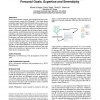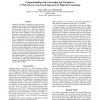17018 search results - page 106 / 3404 » From the How to the What |
CRV
2008
IEEE
14 years 3 months ago
2008
IEEE
The human visual system is often able to recognize shading patterns and to discriminate them from surface reflectance patterns. To understand how this ability is possible, we inv...
CHI
2009
ACM
14 years 4 months ago
2009
ACM
How is work created, assigned, and completed on large-scale, crowd-powered systems like Wikipedia? And what design principles might enable these federated online systems to be mor...
AAAI
2007
2007
Comprehending and Generating Apt Metaphors: A Web-driven, Case-based Approach to Figurative Language
13 years 11 months ago
Examples of figurative language can range from the explicit and the obvious to the implicit and downright enigmatic. Some simpler forms, like simile, often wear their meanings on...
SIGDOC
2000
ACM
14 years 1 months ago
2000
ACM
∗ DSTOP, the Design Support Tool for Operating Procedures, is a relatively simple software tool for support of designers of new interfaces and their procedures for use. DSTOP is ...
BPM
2000
Springer
14 years 1 months ago
2000
Springer
This chapter describes a novel knowledge-based methodology and computer toolset for helping business process designers and participants better manage exceptions (unexpected deviati...


